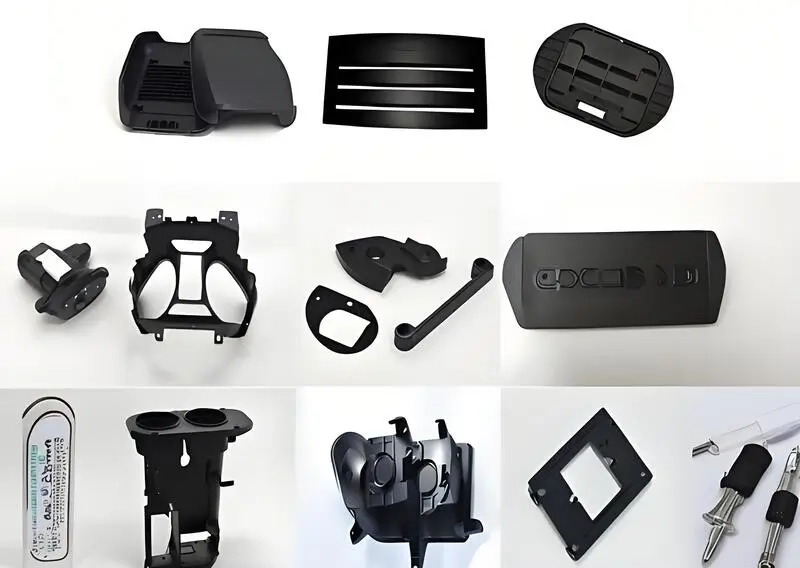Electric vehicles (EVs) started slow. Big car makers were shy about them. Now, things are zooming! It’s not just Tesla anymore. Cool brands like Ford, Chevrolet, and even fancy BMW make all-electric rides. This big switch to EVs shows cars are going electric big time. But, whoa, making all these EVs brings some tricky stuff to figure out.

With EVs popping up fast, tons of people want them. More companies are jumping in. That makes it tough to keep production steady. Here’s where plastic injection molding saves the day. It’s a nifty, stretchy, and super reliable way to make car parts. It’s got loads of production power, both local and worldwide.
Injection Molding for Electric Vehicles: A Whole-Body Option
Plastic injection molding is super cool for EV makers because it’s so flexible. It’s not stuck making just one or two parts. Nope, it can whip up tons of car bits!
From dashboard trim to charging plugs and even battery housings, molded plastics are key. Even with metal pins in a charging gun, fancy molding tricks make these parts quick and easy. Plus, parts needing to fight off chemicals or heat? No problem! Special resins handle those jobs like champs.
Rapid Development Processes for EV Injection Molding Make the Difference
In the EV world, you gotta move fast. Competition’s wild, and new ideas come quick. Injection molding keeps up with zippy prototyping.
Rapid prototyping turns sketches into real stuff. It lets you test ideas super fast. Yay, quicker tweaks! Design teams can check how parts work early and polish them before making tons.
Mass Production Runs Support Automaker-Level Needs
EV makers need speed and tons of parts. The best injection molding buddies build a tough supply chain to churn out loads of stuff. Once a part’s ready from prototyping, it’s gotta roll out in huge numbers.
Injection molding’s awesome because it’s repeatable. One big run can spit out hundreds of thousands of parts. This keeps assembly lines humming without hiccups. Stocking up on parts now also protects against future supply chain oopsies.
Material Qualities Contribute to Better Performance
Plastics in injection molding are way lighter than metal. This cuts the car’s weight a bunch, helping EVs go farther on one charge.
Plus, these plastics are tough against heat and chemicals. And that’s before we talk about super strong resins that handle daily wear like pros. They’re perfect for under-hood spots or shielding delicate electronics.

Examples of Plastic Molding for Electric Vehicles
Injection molding’s all over modern EV designs:
- Transportation injection molding: It’s been big in transport forever. Now it’s key for EVs, making all sorts of parts.
- Door components and panels: Window switches, lock toggles, and big door panels get made with plastic molding.
- Plastic covers and housings under the hood: Some cars have molded engine covers for a snug fit to quiet noise or guard parts.
- Battery cell systems and cell protection: Battery cells use fancy materials, but the cases around them are often plastic.
- Dashboard elements: EVs have cool dashboards with glass and screens, but plastic shapes and frames them.
- Air conditioning system components: AC vents and controls come from custom molds.
Each part gets a special design from molds to work great in cars.
Tap Into Automotive Sector Expertise With Silkbridge
Wanna know more about plastic molding for awesome EV production? Silkbridge has years of know-how helping car makers from start to finish.
At Silkbridge, our smarts and hands-on skills are a big win for partners. We’re ready to help with your next project. Need help picking materials or scaling up your supply chain? Silkbridge is your buddy.
From prototyping to big-time production, we give tips, tricks, and solutions to power the electric vehicle industry today and tomorrow.
Silkbridge Injection Molding Services for Electric Automotive Industry
Silkbridge brings top-notch injection molding for electric car parts. Their engineering crew works tight with OEMs during design to make sure parts can be made without losing the cool ideas.
Their factories handle small test runs and huge mass production orders. They use strong thermoplastics that work in tough EV conditions. From light brackets to tricky multi-material interior bits, Silkbridge makes precise parts with awesome strength-to-weight ratios for modern EVs. Join Silkbridge.
- WhatsApp: +86 18122838771
- Phone: +86 18122838771
- Email:contact@silkbridgeltd.com
FAQ
What is injection molding?
It’s a way to make parts by shooting hot plastic into a mold. The plastic cools into complex shapes.
Why is it important in electric vehicle (EV) manufacturing?
It makes parts fast with steady quality for tons of EVs, perfect for big demand.
What types of parts are made using this process?
Think dashboard trims, battery housings, AC vents, door panels, switches, and charging connectors.
How does it help reduce vehicle weight?
Molded plastic parts are way lighter than metal, boosting energy savings and longer EV ranges.
Can molded plastic withstand heat inside an engine bay?
Yup! Special resins handle high heat near motors or batteries like champs.
Is rapid prototyping possible using this method?
Totally! Molded prototypes give quick feedback for tweaking designs before big production.
Who provides expert services in this field?
Silkbridge offers full help, from prototyping to mass production, made for EV needs.

